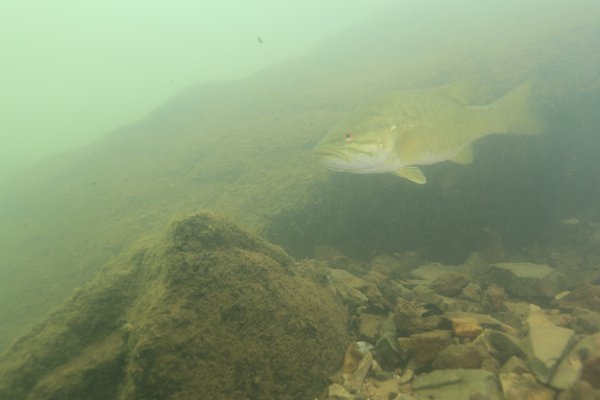Jim Harris Managing Editor Arkansas Wildlife Magazine
MT. IDA — I knew this would be a fishing excursion like no other I’d experienced when my guide, Shane Goodner of Catch’em All Guide Service in Hot Springs, told me I’d need snake boots.
Snake boots? I thought this was to be a wade trip in search of bass. In my mind, I thought something like waders for trout fishing would be in order. “We are going fishing in the water, right?” I asked.
“Yeah, but we’re going to be walking in a lot of places where you’re going to want to be wearing those boots,” Goodner advised.
Knowing that I’d need them for the future plans I have for a turkey hunt next spring anyway, I invested in the best snake boots that the major Springfield, Missouri-based outdoors store sold here, plus a large brim straw hat to shield my fair-skinned neck and face, and wondered just what kind if reptiles I was sure to see.
First, the good news. In all our traipsing around to reach a tributary of the Ouachita River and then negotiate shoals and sometimes chest-deep pools and dry crossings and the 8-foot cliff to climb out of the river bed, we only saw one cottonmouth. He was crossing a deeper spot in the stream just ahead of us, minding his own business and moving on.
Now for the really good news: Though exhausting by the conclusion, it was among the better outdoors experiences of my 60-something years. Just the views of nature alone, from a couple of deer to the butterflies, were priceless.
Goodner reports weekly in the Arkansas Game and Fish Commission’s Fishing Report, but his expertise there is focused on a stretch of Lake Catherine (Ouachita River) below Carpenter Dam at Hot Springs. He was born in California, grew up in Mt. Ida, and has spent 55 years fishing Ouachita River tributaries. He knows this particular stretch of river like I’d know my own house and its every corner.
We caught all three black bass species: largemouth, smallmouth and striper. Goodner had an approach that he said is foolproof for two anglers during this time of year fishing mountain streams like the Ouachita River tributaries, and there are many that extend out of Lake Ouachita, which is the largest lake completely within the state’s borders.
For the day of spin fishing, Goodner was throwing a yellow buzzbait, while he had me casting a 4-inch Zoom Dead Ringer in watermelon seed with red flake. Once Goodner coached me into the correct technique, we were off and running. Of course, showing me how I should deliver the bait into one inviting spot before we started our trek upstream, he landed a nice spotted bass.
We had a long stretch of river to cover, and quickly, so Goodner was often barking like Nick Saban, “We gotta go, Jim,” when I wanted to stay an extra moment in a shaded spot, improving my cast. Moving and casting together, though, was something new, especially when you add in the balancing act required for the unpredictable rocks under my feet.
We caught and released 36 bass that ranged from what appeared to be first-year but fat largemouths to healthy 2-pound smallmouths. We threw back untold numbers of longear sunfish that also wanted to play. We found small pools in which 10 to 15 fish at least bit the baits if not stayed hooked and provided constant thrills. My highlight catch was a nice smallmouth suitable for a photograph. Goodner had hoped we’d entice what looked like a 6-pound bass to bite either of our baits as we watched him swim past us, but it was not to be.
Back in the office, I related my fish story to Sean Lusk, an AGFC Fisheries Division biologist in Little Rock who spent most of his seven years with the agency stationed in Hot Springs. From there, he and Jeff Buckingham, a former AGFC biologist, would often fish throughout the Ouachita Mountain area.
“Oh yeah. One of my favorite things to do around this time of year when the water gets lower is to go out and fish smaller tributaries like that,” Lusk said. “Especially when the water is a little warmer, those stream fish will be extremely active, and it’s fun because they’ll hit a bunch of different (baits). It’s not like you really have to dial them in and match the hatch. You can be slinging Rooster Tails and any number of baits out there and you’re going to catch fish.”
While all of the Ouachita River tributaries “are not created equal,” Lusk said, and may not offer quite the experience I enjoyed, he says there is potential in the main stem of the river and the major forks, like the South Fork and North Fork, to catch all three of Arkansas’s black bass species.
Goodner pointed out to me that the fish we were catching, though genetically identical to black bass in Lake Ouachita, were different from “lake fish.”
Lusk explained it further: “A lot of those stream fish, they’ll remain in the stream. More than likely the fish you guys were catching are steam-residents, it’s not like they live their life by the spillway and then migrate up in there.” Where there is little pressure on some of these tributaries, the fish immediately strike a bait.
Snake boots and a slight fear of hiding reptiles aside, access may be the only obstacle to anglers finding the perfect, active tributary to fish. Some streams have private land on both sides; you will need permission, or a guide with that permission, to find some of these gorgeous spots full of plentiful bass. But public access points also are available, especially on the Ouachita’s main stem and on any part of the water that abuts U.S. Forest Service land, which can be accessed by the public. The AGFC and the Army Corps of Engineers have access points on the main stem tributaries, Lusk noted, including one at the Twin Creek boat launch on the southwestern corner of Lake Ouachita.
“You could launch a boat there and you could run up the South Forth. Depending on how low the water was, you could run up that sucker pretty far,” Lusk says. “Or, if it’s not deep enough at that time of the year you could get out of your boat and start wading your way up. You have to stay below the ordinary high water mark in areas where private land is on either side.”
The main stem of the Ouachita is deep for several miles and more suited to floating fish trips; you have to travel several miles toward Mena to get into more shoal-type areas for wade fishing this time of year, he said.
For the average sportsman who would prefer something else to do in the outdoors when his or her friends are in the deer woods, Lusk says, a fall fishing trip in the mountain river tributaries can’t be beat.
“Find one of these trips. Look where we have a Game and Fish access. This isn’t restricted to just the Ouachita, look at any of our mountain tributaries. Right now river fishing can be really good. The fish now are less finicky than they will be in other times of the year in terms of that one bait that they’re looking for. The fish are hungry and they’ve got a wide variety of diet items that they’re interested in, so you can get away with throwing a number of different things and be successful.”







